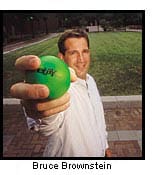Entrepreneurs and academics alike find that dealing on the Internet is uncharted, unregulated and, in many cases, potentially profitable.
Earlier this summer Bruce Brownstein, W’80, paid $59 for a new video game for his children. After watching it once and deciding that it was too violent, he tried to sell the barely used game to a dealer. The dealer’s best offer: $10.
Unwilling to take that loss, Brownstein’s wife Suzanne decided to try another option: selling it through eBay, the fast-growing online auction company in San Jose, Calif., where Brownstein is director of sales. Brownstein listed the game on the company’s website and invited potential buyers to bid. Seven days later, he had 21 bids — and clinched the deal at $53. “That was the first time we used eBay’s auction system to sell something,” he says. “It surprised me how much fun it was.”
 Thousands of people apparently agree. In the two-and-a- half years since eBay was founded, it has emerged as one of the Internet’s hottest sites. Media Metrix, a New York firm that measures web traffic, has just named it the world’s biggest personal trading site. Each day buyers and sellers conduct some 40,000 online auctions over eBay’s website, trading everything from Barbie dolls to rare coins. As the deals multiply, eBay — which takes a small cut on each transaction — has seen gross merchandise sales climb to $250 million in the first half of this year, earning gross profits of $13 million. Because eBay simply matches buyers and sellers, it has neither inventory nor shipping costs. The company is now on its way to Wall Street for an initial public offering.
Thousands of people apparently agree. In the two-and-a- half years since eBay was founded, it has emerged as one of the Internet’s hottest sites. Media Metrix, a New York firm that measures web traffic, has just named it the world’s biggest personal trading site. Each day buyers and sellers conduct some 40,000 online auctions over eBay’s website, trading everything from Barbie dolls to rare coins. As the deals multiply, eBay — which takes a small cut on each transaction — has seen gross merchandise sales climb to $250 million in the first half of this year, earning gross profits of $13 million. Because eBay simply matches buyers and sellers, it has neither inventory nor shipping costs. The company is now on its way to Wall Street for an initial public offering.
eBay is hardly alone. It is one of thousands of new businesses springing up to create the global digital bazaar that is driving the explosion in electronic commerce. Jupiter Communications, a New York City consulting firm, estimates that the number of online shoppers increased from 10 million last year to 16 million this year and will swell to 61 million by 2002. The Gartner Group, a consulting firm in Stamford, Ct., predicts that online consumer sales will jump from $6 billion this year to $20 billion by 2000. The growth in business-to-business deals, in the same period, will go from $15 billion to $175 billion.
So far, compared with the economy as a whole, these numbers are minuscule. Online consumer sales, for example, amount to just 0.2 percent of U.S. retail sales. Yet the reason for the breakneck growth of web commerce is that once people buy books from Amazon.com or music from CDNow, they tend to get hooked on the speed, ease and convenience of the experience. According to a U.S. Department of Commerce report, “The [World Wide Web’s] pace of adoption eclipses all other technologies that preceded it. Radio was in existence 38 years before 50 million people tuned in; TV took 13 years to reach that benchmark. Sixteen years after the first PC kit came out, 50 million people were using one. Once it was opened to the general public, the [World Wide Web] crossed that line in four years.”
This electronic commerce explosion has provided opportunities and challenges to both Wharton faculty and alumni. The Wharton Electronic Commerce Forum brings faculty together to work on these issues. Its director, Eric Johnson, the David W. Hauck Professor of Marketing, Operations and Information Management and Psychology, is studying consumer behavior on the Internet. In addition, he has looked into whether declining prices on the Internet will depress profits for companies doing business on the web as well as their real-world rivals. Gerald Lohse, a research fellow at the Forum, is examining factors that make websites effective. Gerald Faulhaber, professor of public policy and management, is researching the development of broadband infrastructure for the web.
Stephen J. Kobrin, William H. Wurster Professor of Multinational Management and director of The Joseph H. Lauder Institute of Management and International Studies, is doing research on taxation and regulation of electronic commerce. Alan Montgomery, assistant professor of marketing, is studying web usage patterns among Internet users.
Among alumni, the boom in electronic commerce has launched a number of entrepreneurial endeavors. In addition to Brownstein, who is helping drive eBay’s growth, there is Richard Thompson, WG’96, chairman of San Francisco’s Flycast Communications, a fast-growing agency for web-based advertising; Jeffrey Hyman, W’90, CEO of Career Central in Palo Alto, which matches MBAs and software professionals with jobs; and Farhad Mohit, WG’96, CEO of Binary Compass, a Los Angeles firm that measures customer satisfaction on the Internet. Many of these alumni are research associates with the Wharton Electronic Commerce Forum.
Lower Prices and More Value
While electronic commerce has created opportunities, it has also unleashed new uncertainties. Among the most paralyzing of these for businesses is whether the Internet will drive prices down so much that profits will disappear. Consider these scenarios: As more consumers use so-called price robots to surf the web to locate the lowest air fares, won’t airlines be forced to keep dropping prices in order to fill the seats? And as growing numbers of book-lovers buy books online from Amazon.com, which can sell them less expensively because it has no stores or inventory to maintain, won’t that force rivals like Barnes & Noble and Borders to keep lowering prices in order to remain competitive? And if prices keep falling, how can anyone make profits off the web?
Johnson’s research indicates, however, that several factors determine companies’ profitability. For starters, price is hardly the only issue that motivates consumers. “Our studies show that people care about many more things than price,” he says. Recognizing this reality, most successful online merchants don’t just offer prices that are lower than those found in a real-world store; they also add value in other ways. For example, the online wine retailer Virtual Vineyards provides more information about wines than customers might get in most wine stores. Virtual businesses also learn their customers’ preferences and offer them choices that actual stores cannot. Amazon.com, for example, records buyers’ purchases and follows up with recommendations of other books. Peapod, the Skokie, Illinois-based online grocer, keeps shoppers’ last three grocery orders so that they do not have to create a new shopping list each time. Peapod also allows customers to sort products on its site by such features as fat, sodium or cholesterol content.
Another key factor, Johnson argues, is that while the web may hammer down prices, it also dramatically slashes costs. And when prices decline, the volume of business generally increases. So as long as prices are higher than costs, an increase in volume should lead to profits. A case in point: online stock trading. As online brokerages like E*Trade have emerged, stockbrokers have witnessed a sharp decline in costs per trade from $400 to $40 to $7.99. But because orders over the Internet are placed electronically, that industry has also seen transaction costs plummet. “If trading volume increases, the stockbrokers can maintain their profitability,” Johnson says. Declining trading costs generally lead to an increase in trading volume for two reasons. First, existing customers place more orders since each transaction costs less; and second, new customers who were unwilling to trade at higher costs are drawn into the market.
Thompson, chairman of ad agency Flycast Communications, would probably agree with the theory that profitability can be sustained so long as volume continues to increase. One of his major clients is a Palo Alto firm named Speedlane, which sells software that speeds up the movement of data through modems. Customers download the software off the company’s web site for $19.95, so its cost of selling each additional copy is negligible. As long as Speedlane spends less than $20 to acquire each new customer, it keeps making money.
The desire to work with such clients was one of the reasons Thompson launched Flycast Communications. In 1995, with the rapid increase in web-based publishing, the hot issue was how companies could advertise their products on the web. During the fall of 1995, Thompson, then a second- year MBA student, mulled over various options, chatting with friends over pizza and beer in Vance Hall. They went through four or five business plans; each time they thought of an idea, someone else was already doing it. Finally, Thompson came up with a vision.
The idea was simple: the company would create a platform where ad-space on the web could be bought and sold, much as stocks are traded on the Nasdaq. Companies that wanted to buy ad space on the web could do so using Flycast’s software, which would also monitor how effectively different ads were working. Flycast’s model has clearly worked for clients like Speedlane, which Thompson estimates now spends about $100,000 a month to buy 33 million advertising banners, or digital blocks of text and images.
Keep It Simple
Part of Speedlane’s success, Thompson says, stems from one factor: mousing around its website is easy. That conclusion is at the heart of Lohse’s research on what makes some web-based retailers click, while others are lost in obscurity. Lohse along with Peter Spiller, a consultant at McKinsey & Co., analyzed the websites of the most effective Internet retailers in the hope that this might offer pointers to others.
The core of their message is that nothing succeeds like simplicity. “Each additional mouse click that a buyer has to make reduces the possibility of an online sale,” says Lohse. He compares the situation to a customer who might go into a convenience store to buy coffee, but walks away if he sees 20 people in line before him. Most effective online retailers shorten the process of getting price and product information as well as buying the product. A case in point: Amazon.com’s “one-click” shopping system, which allows potential buyers to instantly purchase books of their choice.
Lohse says that florists, too, have figured out how to sell effectively on the Internet. For example, 800 Flowers’ web site has a Quick Shop feature. Clients see photographs of popular selections, such as a bouquet of a dozen red roses that cost $60, which they can buy by clicking on a button. The website also lets buyers search for flowers by price or by occasion. Says Lohse: “Whom do you buy from? From those who make it easiest for you to shop.”
Lohse and Spiller found that presenting price and product information in a simple format makes a tremendous impact on an online store’s performance. “At least 60 percent of the variation in the monthly sales data of online retailers can be explained in terms of how price lists are presented,” Lohse says. Another factor is the number of store “entrances,” or Internet sites from which potential buyers can access the site. Each link that a store establishes with other websites increases its ability to attract online traffic. In addition, just as in the physical world, stores with a wider selection draw more shoppers. Features such as a Feedback section or Frequently Asked Questions also help increase online sales.
If Lohse has a message for retailers who are spending hundreds of thousands of dollars on jazzing up their web sites, it is this: Keep it simple. “No amount of ‘sparkle’ in the presentation of products can compensate for poor design features,” he says.
Customer Satisfaction
A well-designed site can attract large volumes of customer traffic. But how satisfied are those buyers, and how would they compare one web-based retailer to its rivals?
The drive to answer these questions inspired the June 1996 launch of Binary Compass Enterprises, a company that wants to be “the Internet leader in monitoring customer satisfaction.” Headed by Farhad Mohit, the company publishes the BizRate Guide, a report that ranks the best merchants in terms of customer satisfaction, based on more than 12,000 buyer surveys. In July, for example, Crutchfield, a Virginia-based retailer of consumer electronics products, topped that list.
Mohit, an entrepreneurial management major who had earlier worked for Andersen Consulting, says he “saw the web crawl up” while he was at Wharton and decided that he wanted to work in this field. By September 1995, he had joined a group of fellow students and faculty members to start an Internet research firm. Their original idea was that Binary Compass could do e-commerce research and give that away, while collecting ad revenues for BizRate. As often happens with Internet-inspired ideas, exactly the opposite has occurred. “Our business model has been reversed on its head,” Mohit says. “We don’t take any advertising for BizRate, and we sell research to the merchants.”
 While Mohit caters to merchants, Jeffrey Hyman works with corporate recruiters as CEO of Career Central, an online recruitment firm. While he was at Wharton, he realized that corporate recruiting — making connections between candidates and companies — was a highly inefficient process. Companies spent more than $5 billion on executive search firms and $5 billion more on newspaper classifieds to hire people. “Ten years ago I didn’t know how to make the market efficient,” he says.
While Mohit caters to merchants, Jeffrey Hyman works with corporate recruiters as CEO of Career Central, an online recruitment firm. While he was at Wharton, he realized that corporate recruiting — making connections between candidates and companies — was a highly inefficient process. Companies spent more than $5 billion on executive search firms and $5 billion more on newspaper classifieds to hire people. “Ten years ago I didn’t know how to make the market efficient,” he says.
After a stint with Black & Decker, Hyman earned his MBA at Kellogg, eager, when he graduated, to hook up with a high-tech company. Unfortunately, few such companies came to Northwestern to recruit. After flying frequently to the West Coast at his own expense, Hyman landed a job at Intuit, the Mountain View, Calif., company that makes Quicken software.
During that time, Hyman saw that the Internet offered him a way to overcome the inefficiency of the recruiting market. Research showed that he was not alone in the predicament he had been through; dozens of MBAs had experienced trouble finding jobs they liked. In June 1996, Hyman formed MBA Central, a firm that used the Internet to connect MBAs with prospective employers. During the last few months, the company expanded its recruiting to include software professionals, and changed its name to Career Central to reflect that addition.
When a job opens up, the company’s database makes it easy to identify appropriate candidates, who are notified by e-mail. Using this system, Career Central has placed “hundreds of MBAs” in new jobs at firms ranging from giants like Booz Allen to five-person start-ups. “We often work with small companies that cannot afford to spend the $25,000 to $30,000 that a traditional headhunter charges,” notes Hyman, adding that Career Central charges roughly $3,000 and works 10 times faster.
Getting on the Bandwidth Bandwagon
Companies like Career Central are using the Internet to reinvent the business of corporate recruiting. In its own way, each company engaged in electronic commerce is trying to do just that in its own field. The hurdle faced by many of them is that at today’s level of technology, while zapping text data back and forth over the web is hardly a problem, large files of video and audio material are tougher to move around. The phone network, which carries most Internet traffic, does not have enough bandwidth — or large enough pipes — to smoothly carry massive, multimedia files. But as electronic commerce evolves, more and more broadband networks, whose capacity is large enough to transmit multimedia content, will become necessary. How will that happen?
Faulhaber has worked on the question of broadband infrastructure with PhD student Christiaan Hogendorn. Faulhaber points out that for the Internet — and for electronic commerce — “broadband networks may be as significant as the deployment of telephone networks in the early part of the 20th century or of cable systems in the 1970s and 1980s.” Real estate brokerages that want potential homebuyers to do virtual walk-throughs of homes, for example, will need networks that can transmit data-heavy video files. The phone system is fast becoming a choke-point because it is narrowband, Faulhaber notes.
So how will high-bandwidth networks evolve? Faulhaber explains that traditionally, infrastructure networks have usually been so-called natural monopolies that governments have closely regulated. Will broadband networks also emerge as “natural monopolies?” According to Faulhaber and Hogendorn, who have developed a model using engineering data, that need not necessarily be the case. Some form of imperfect competition could emerge if the government does not use regulation to suppress it.
These seemingly arcane issues suddenly burst into the news in July when AT&T announced its $48 billion merger with cable giant TCI, declaring that a major goal was to offer a “whole house” service, including telephony, high-speed Internet access and television. Faulhaber, however, has doubts about whether AT&T will use the deal with TCI to enter the broadband networks market. “TCI’s network is pretty old and its cable systems are probably not up to snuff in terms of Internet servers,” he says. AT&T’s real interest in TCI may lie in the fact that the company and its affiliates have 21 million subscribers in the U.S. and their network passes in front of 33 million homes. “That gives AT&T actual contact with the customer in terms of a physical connection,” Faulhaber says. “That is very important for AT&T because the company lost that at the time of the Bell system divestiture. This puts AT&T back in business.”
While Faulhaber explores how regulation might affect the Internet’s physical infrastructure, Stephen Kobrin has been asking similar questions regarding the regulation of electronic commerce. Specifically, he has been studying how electronic commerce will be taxed. “A tax-free Internet seems reasonable right now, when the volume of e-commerce (in relation to total trading) does not amount to much,” he says. Governments, however, have a sharp nose for potential sources of revenue. As more business moves onto the web, governments will not forgo the revenues they could earn from millions of electronic commerce transactions around the world.
Taxing electronic commerce, however, poses complex problems. “In the past, tax jurisdictions have been geographic,” Kobrin explains. “We ask where the transaction takes place and where an income stream is produced, and that is how tax jurisdictions are decided. Sometimes there are conflicts, but we work them out. But when transactions take place in cyberspace, where they take place is not clear.”
For example, Kobrin says, consider a teenager in Germany who buys an album from a French virtual music store by downloading it from a website maintained in India. Where did that transaction occur? “Physical location has no relation to virtual location,” Kobrin says. “So the question is, how do you tax such transactions?”
Despite the U.S. government’s laissez-faire stance towards the Internet, Kobrin says he doesn’t believe that electronic commerce will remain tax-free for long. “The assumption right now is that there are two opposite poles,” he explains. “First, that everyone will tax every transaction to death, and second, that electronic commerce should be left alone.” Kobrin argues that neither of these positions is reasonable — or, ultimately, realistic.
One solution might be to set up an international agency and find some equitable means to distribute tax revenues among different countries. That, however, would be tough to implement. “It’s difficult to believe that the U.S. government is going to give up its taxing power over income from electronic commerce transactions to some international agency,” Kobrin says. “The U.S. doesn’t even want to support the IMF. So I don’t know how this story is going to work out.”
Regulating electronic commerce presents an even more formidable challenge than taxation. Each market, Kobrin observes, is embedded in a social system. “Somebody has to set the rules, provide for adjudication of contracts and set up a framework of laws,” he says. “Every market has to have some social controls over the economy and economic actors. It’s ridiculous to think that electronic commerce will be free of social controls.” The key issue, he says, is how to embed a market that exists in cyberspace within a social system, so that firms are regulated and customers are protected against fraud. “What’s a void contract in cyberspace?” he asks.
Time will probably answer that question and others. Fast as it is growing, electronic commerce is still an infant. As it develops, practical solutions will emerge — some from governments, others from markets. eBay’s Brownstein notes that his company has set up a system to establish trust among strangers who trade on the web: they assign ratings to their experience with different traders. That system makes it hard for someone who accumulates negative points to trade on the system. Mohit’s BizRate service offers a similar solution by letting customers rank retailers.
Even as these mechanisms evolve, one fact remains clear: electronic commerce has arrived — and nothing will turn the clock back. “We’d like our company to be swept up in the success of electronic commerce,” Brownstein states. “Some people say there’s a lot of hype around it, but if a rising tide lifts all ships, we’d like to rise, too.”


























